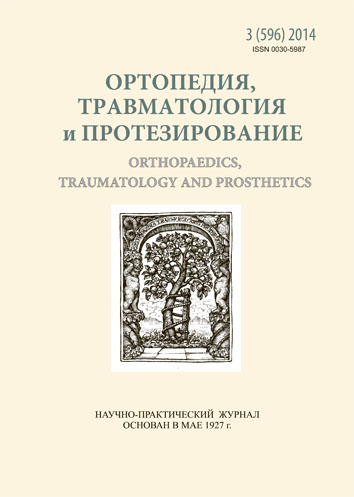Medical tactic in hand polydactyly in children
DOI:
https://doi.org/10.15674/0030-598720143104-107Keywords:
polydactyly, malformations of the hand, medical tactic, correction of deformityAbstract
Untimely correction of anomalies of fingers and hands or inefficiently performed reconstructive operations may affect the processes of adaptation of children to life. Objective: To improve outcomes in children with polydactyly by optimizing the methods of surgical correction of congenital hand pathology. Methods: During the period from 2000 to 2012 in 118 patients (70 boys, 48 girls, age to 6 years) with polydactyly there were performed 141 operations on 136 hands. There were 68 children with radial form of polydactyly, 17 with ulnar form, and 3 with central one. For establishment of the nature of the pathology examination with using of radiological, CT, and ultrasound dopplerography mapping was done. Results: In the case of the main finger deformity after removal of additional finger we performed corrective osteotomies, modeling resections of articular surfaces, and restored capsular-ligamentous apparatus. In cases of ulnar polydactyly with thickening of V metacarpal bone on the wide head of which there are two claw like little fingers we removed less developed one, cut off the abductor digiti minimi, restored lateral metacarpophalangeal ligament, fixed the muscle to the proximal phalanx, angular deformity of the V finger we eliminated by wedge osteotomy with K-wire fixation. In cases of central polydactyly after removal of extra finger we used created from a remote segment reserve of skin for closing the skin defect on lateral surfaces of the fingers with simultaneous correction of axial deformities. Long-term outcomes were followed up during the period of 1 to 10 years in 78 children: good results were obtained in 44 cases, satisfactory — in 27, and unsatisfactory — in 7 cases. Errors and complications: deviation of the main finger, nonunion of bone surfaces, scar deformities, limitation of movement. Conclusions: While choosing the method of surgery and duration of its execution one should establish the primary and the secondary fingers in cases of radial polydactyly. Zigzag incisions, rational skin, bone and tendon plasty allow to prevent the formation of scar contractures and secondary deformities of fingers and contribute to the restoration of the hand function.
References
- Kawabata H. Revison of residual deformities after operation for duplication of the thumb / H. Kawabata // J. Bone Joint Surg. — 1990. — Vol. 72, № 7. — P. 988–998.
- . Agranovich O. E. Congenital malformations of the first ray of the hand in children: dis. ... Doctor Medical Sciences / O. E. Agranovich. — St.Petersburg, 2001. — 562 р.
- Andruson M. V. Free dermepenthesis in surgical treatment of deformities of the brush: аuthor. dis. ... Doctor Medical Sciences / M. V. Andruson. — M., 1970. — 29 p .
- D. Buck Loud // Recent advances of plastic surgery / D. Buck Loud // Moscow, 1985. — Р. 143–159.
- Volkova A. M. Hand Surgery. In 3 volumes / A. M. Volkovа. — T. 2. — Ekaterinburg: Ural Worker, 1993. — 256 p.
- Experience of treatment of radial polydactyly / N. A. Latypova, G. G. Netov, I. E. Mikusev [et al.]: Mat. conf. ["Modern technologies of diagnostics, treatment and rehabilitation of injuries and diseases of the hand."] — Moscow, 2005. — P. 217–219.
- Tyazhelkov A. P. Reconstructive treatment of complex hand malformations in children: dis. ... Doctor Medical Sciences / A. P. Tyazhelkov. — Irkutsk, 1993. — 33 c.
- Shvedovchenko I. V. Congenital hypoplasia brush in children: author. dis. ... Doctor Medical Sciences / I. V. Shvedovchenko. — St. Petersburg., 1993. — 42 p.
Downloads
How to Cite
Issue
Section
License
Copyright (c) 2014 Oleksandr Sedykh, Yury Paschenko, Oksana Piontkovska

This work is licensed under a Creative Commons Attribution 4.0 International License.
The authors retain the right of authorship of their manuscript and pass the journal the right of the first publication of this article, which automatically become available from the date of publication under the terms of Creative Commons Attribution License, which allows others to freely distribute the published manuscript with mandatory linking to authors of the original research and the first publication of this one in this journal.
Authors have the right to enter into a separate supplemental agreement on the additional non-exclusive distribution of manuscript in the form in which it was published by the journal (i.e. to put work in electronic storage of an institution or publish as a part of the book) while maintaining the reference to the first publication of the manuscript in this journal.
The editorial policy of the journal allows authors and encourages manuscript accommodation online (i.e. in storage of an institution or on the personal websites) as before submission of the manuscript to the editorial office, and during its editorial processing because it contributes to productive scientific discussion and positively affects the efficiency and dynamics of the published manuscript citation (see The Effect of Open Access).














